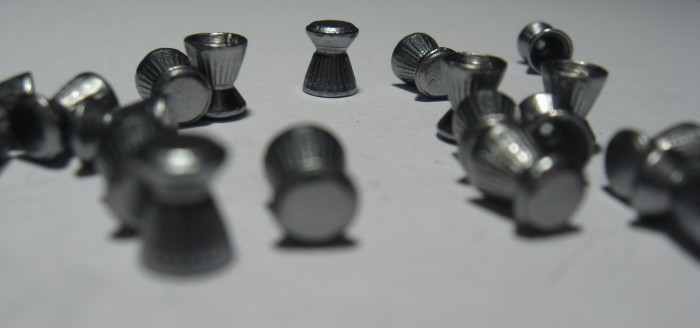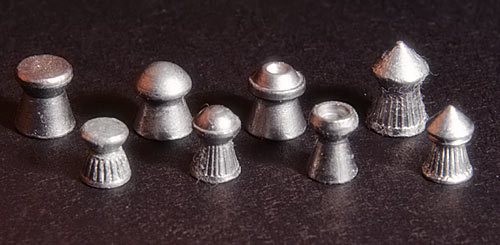This month, we take a look a closer look at airgun pellets. If you’re pondering pellet selection, whether it’s target shooting or hunting on your airgun or air pistol, this is the post to help you choose the right buy…..

Pellet Size
The most important choice when it comes to selecting pellets is their calibre. Now, obviously the pellets you choose have to match the calibre of the gun you are firing, but different sizes have different characteristics.
The two main sizes of pellet are .177 (4.5mm) or .22 (5.5mm). The legal limit in the UK for power on air guns is 12ft/lbs for rifles and 6ft/lbs for pistols, and due to the way the law works smaller pellets have to fly faster to meet this limit. This means that .177 pellets achieve much higher velocities than .22 pellets and as such provide flatter trajectories for increased accuracy. Pellets in the .22 calibre fly with more of a looped trajectory, and so they may require slight elevation adjustments, especially at range.
However, the benefit of the .22 pellet is its greater mass. This transfers more energy into the target, essentially increasing the force that the target is hit by. This is important for pest control as it ensures clean one hit kills, as opposed to .177 pellets that can pass straight through the animal due to their smaller size and faster speed.
What this essentially means is that .177 are more suited for target shooting. It is the calibre everyone uses in the Olympics, whilst the .22 is more suited to pest control. There is a calibre in between the two, .20 (5.0mm) which aims to combine the accuracy of a .177 with the power of a .22 and it does do this to some extent. The only downside to a .20 pellet is due to it being a less popular calibre, not as many different kinds are available and some gun shops may not even stock them.
There are also larger calibres available, such as .25 and .303, but in my opinion these are only really worth bothering with if you’re shooting an FAC rifle that is over 12ft/lbs, as the extra mass of the pellet requires more force to push it. These larger pellets are designed for hunting at long ranges and can provide devastating power at the 20-30ft/b range.
Weight plays a similar role as calibre, with heavier pellets being more powerful but sacrificing a little accuracy thanks to having more of a looped trajectory. The pellets weight is measured in grain with 8-10gr being about average for .177 and 15-18gr being about average for .22.
Pellet Shape
The shape of the pellet is almost as important as the size, and there are lots of different styles of pellet available that all perform vary different roles. Choosing the correct style of pellet can effect drastically improve the effectiveness of your shooting.
Flathead or Wadcutter

These pellets are designed for practice and target shooting and are so shaped to cut clean holes in the target for accurate scoring. The pellets are usually cheap and are available from many different brands. The downside of this shape is that they are less aerodynamic than some of the other types available and will start to tumble at long range. Also thanks to their flat headed shape they are not good for penetration and so not suitable for pest control at all.
Domed
Probably the most common type of pellet available, these pellets feature a domed head and are the jack of all trades in the pellet world combing accuracy and penetration for great all round performance. Suitable for both practice, target shooting and pest control, the domed shape allows air to flow around the pellet more effectively creating less turbulent air behind the fired pellet, for a flatter trajectory.
Because these pellets are some of the most popular designs available, there loads of different pellets to choose from by many different brands such as Air Arms, JSB and ProShot.
Pointed
These pellets feature a pointed tip that is designed to maximise penetration into targets and as such would seem to be the hunters logical choice, however, in practice this is often not the case. The problem with pointed pellets is that any slight damage to the point can drastically affect accuracy, as it greatly effects airflow around the pellet in flight. As pellets are often packed loose in tins, this can happen quite easily, and so, from my experience, most hunters much prefer domed pellets, as the penetration is not that different.
Hollowpoint
These pellets feature either a little gap in the nose or a plastic/metal tip. The idea behind this is when the pellet hits the target either plastic tip or air inside the hollowpoint drives back inside the pellets to aid expansion inside the target, and ensure one hit kills, by creating a much larger wound channel.
The plastic/metal tipped pellets suffer from similar problems to the pointed, in that any slight variation to the way the tip is seated can drastically effect accuracy. For this reason I would personally avoid them for anything other than close range dispatching. Hollow points are more useful for pest control, but you will still find the accuracy dropping off after around 25 metres in most guns. This is simply due to the fact that the shape of the hollowpoint affects the way the air flows around the pellet.
The ‘Skirt’
Some brands of pellets will let you choose what size of skirt the pellets have. This will be displayed as 0.01 differences in the calibre, for example .177 pellets will be marked as 4.51, 4.52, 4.53, etc. The idea behind this is the wider the skirt, the better the seal behind the pellet. This provides a greater pressure behind the pellet forcing it out at greater speed and therefore improving accuracy.
The only trouble that can arise when choosing a larger skirt is that some magazines can be very picky when it comes to accepting pellets. This seems to particularly affect semi automatic weapons such as CO2 powered pistols and Co2 air rifles. I would use 4.5s and 4.51s in these sort of weapons anyway, as they are not designed for pin point precision.
Some of the Best
From my experience shooting air rifles there area few kinds of pellet that stand above the rest in terms of performance, power and quality of manufacture. Bear in mind that pellets will behave differently in different rifles, even those of the same brand and model. So this is just a guide to what works well in my experience, and for the people I have shot alongside.
Recommended: Air Arms Field
The undisputed kind of domed pellets, the Air Arms pellets are supposedly carefully selected to to provide excellent shot to shot consistency, and even looking at the pellets in the tin, they look very uniform and free from imperfections on the surface. They also allow you to choose skirt size between .51 and .52, which is nice, with the .52 pellets coming out on top.
When it comes to shooting the Air Arms pellets, they really are the jack of all trades and are accurate enough for target shooting and provide significant penetration when it comes to stopping small birds and mammals.
The only downside to these pellets is they are quite pricey, costing between 10 and 13 pounds a tin, with their competitors costing up to 50% less. Also there is only one grain size available, 8.4gr in .177 and 16gr in .22. These are pretty average grain sizes for pellets of this type but it would be nice to have something to choose from, maybe something lighter for faster velocities and more accurate target shooting.
Other domed pellets to consider : JSB Exact Premium, ProShot Precision, Daystate Heavyweight FT
Recommended: Bisley Practice
These are some of the cheapest pellets that money can. But don’t let that put you off, these practice pellets are made to a great standard and feature a classic wadcutter shape to cut clean holes in a paper target, allowing you to see exactly where you have shot. For this reason I think the Bisley practice pellets make a great choice for zeroing scopes in at short range and, well, practising.
These pellets are not going to be that suitable for pest control or anything at long range but for the money I think they make a welcome addition to anyone’s arsenal and save you wasting you more expensive pellets when zeroing up.
Other flatheads to consider : RWS Hobby, H&N Finale Match Light, RWS R10 Match
Recommended: Crosman Piranha
Based on the ever popular Crosman hollow point pellets, the Piranha features a star shaped cut out instead of a standard dome that improves the pellet in two ways. Firstly it enables the hollow point to open out easier and more uniformly upon penetration into the target. This provides quicker expansion and a larger wound channel for quicker and cleaner one shot kills.
The star shape also reduces turbulence around the nose of the pellet for better accuracy. These pellets are never going to be match target winners but when it comes to pest controlling these pellets are absolutely devastating at close to medium range, even at 12ft/lbs.
Other hollow points to consider : H&N Barracuda Hunter, Bisley Pest Control
Check our our full range of airgun pellets here.

Hello
Nice Blog and Advices.
I have problems to get information what the maximal allowed Sub12 Speed is for .177 – .22 and .25 Caliber Air Pellets and Slugs also the maximal Weight for each Caliber, could You give me and other People some advise, Please?
Regards Pumuckell